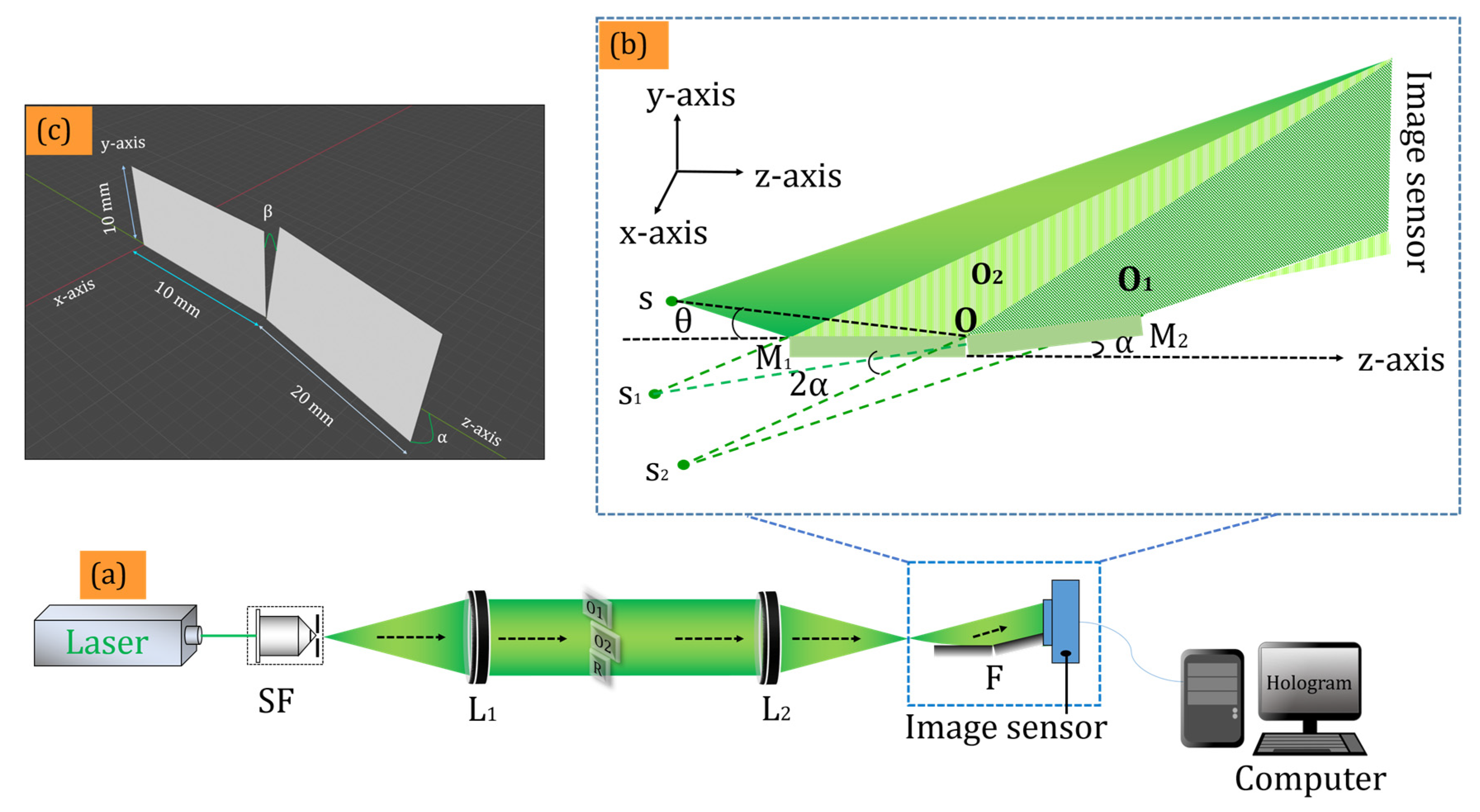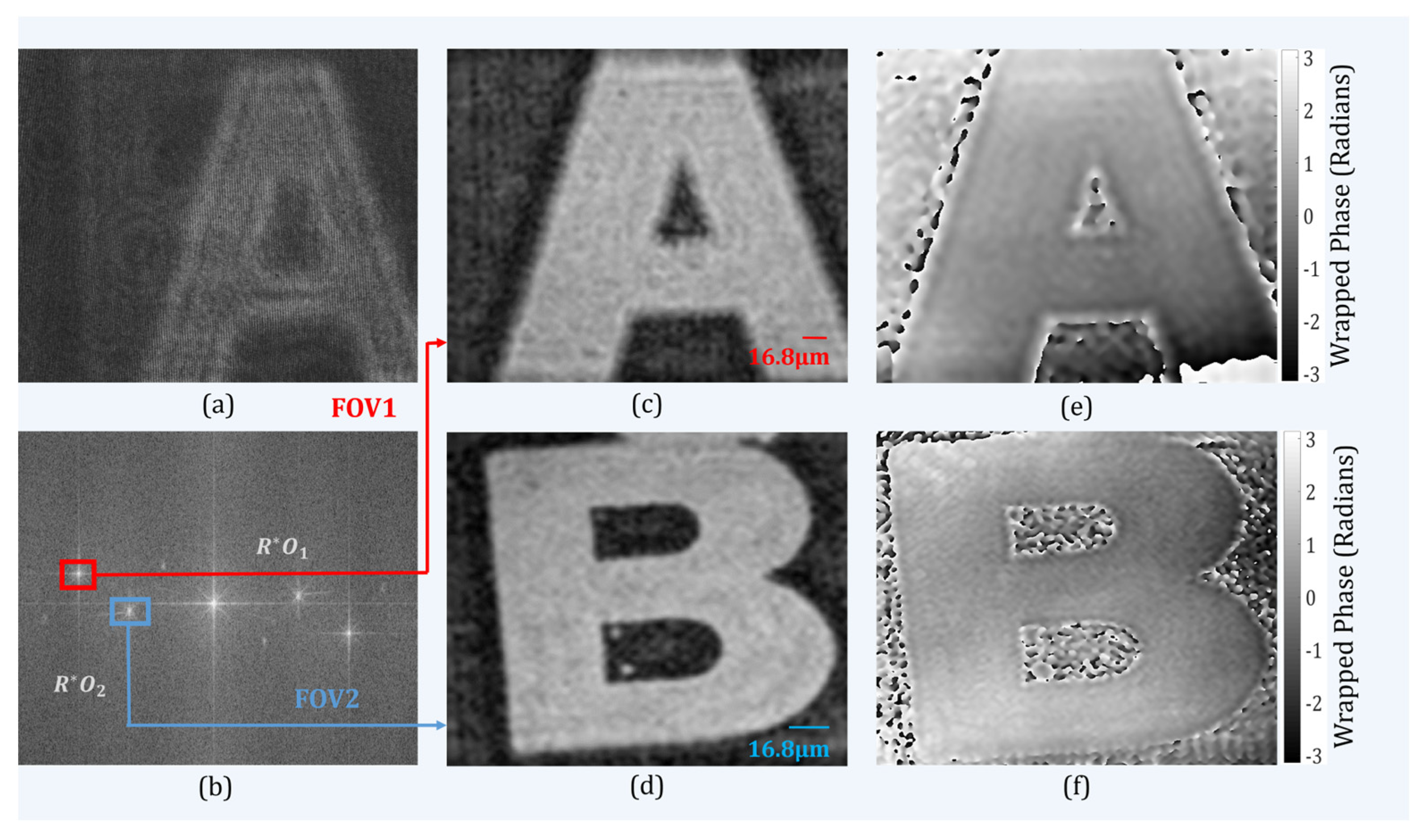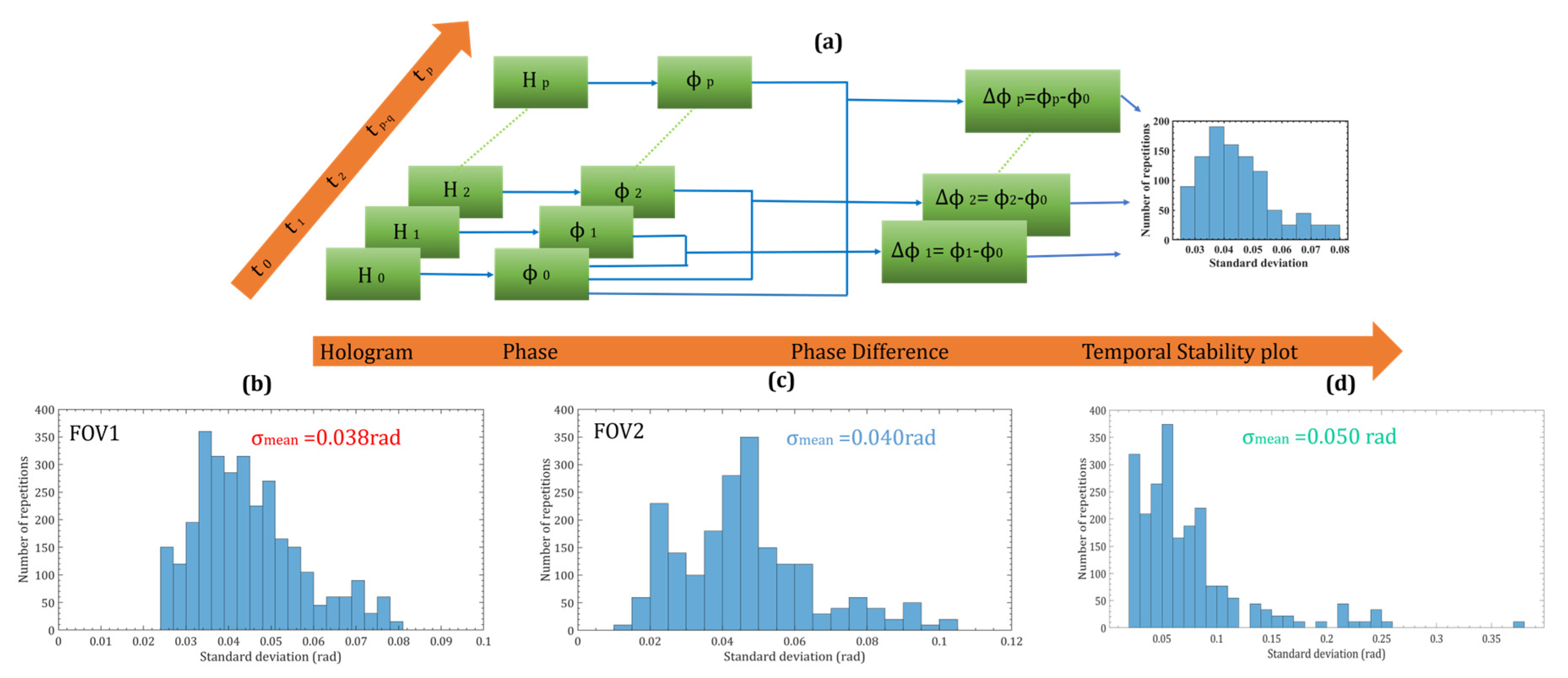Dual Field-of-View Off-Axis Spatially Multiplexed Digital Holography Using Fresnel’s Bi-Mirror
Abstract
1. Introduction
2. Materials and Methods
3. Results and Discussion
3.1. Field of View
3.2. Resolution
3.3. Temporal Stability
3.4. Step Height Measurement Results by the Proposed System
4. Conclusions
Author Contributions
Funding
Institutional Review Board Statement
Informed Consent Statement
Data Availability Statement
Acknowledgments
Conflicts of Interest
References
- Javidi, B.; Tajahuerce, E. Three-Dimensional Object Recognition by Use of Digital Holography. Opt. Lett. 2000, 25, 610. [Google Scholar] [CrossRef] [PubMed]
- Schnars, U.; Jüeptner, W. Digital Recording and Numerical Reconstruction of Holograms. Meas. Sci. Technol. 2002, 13, R85–R101. [Google Scholar] [CrossRef]
- Kim, H.-W.; Cho, M.; Lee, M.-C. Noise Filtering Method of Digital Holographic Microscopy for Obtaining an Accurate Three-Dimensional Profile of Object Using a Windowed Sideband Array (WiSA). Sensors 2022, 22, 4844. [Google Scholar] [CrossRef] [PubMed]
- Chen, S.; Li, C.; Ma, C.; Poon, T.-C.; Zhu, Y. Phase Sensitivity of Off-Axis Digital Holography. Opt. Lett. 2018, 43, 4993. [Google Scholar] [CrossRef]
- Sheridan, J.T.; Kostuk, R.K.; Gil, A.F.; Wang, Y.; Lu, W.; Zhong, H.; Tomita, Y.; Neipp, C.; Francés, J.; Gallego, S.; et al. Roadmap on Holography. J. Opt. 2020, 22, 123002. [Google Scholar] [CrossRef]
- Kumar, R.; Dwivedi, G. Emerging Scientific and Industrial Applications of Digital Holography: An Overview. Eng. Res. Express 2023, 5, 032005. [Google Scholar] [CrossRef]
- Xia, P.; Ri, S.; Inoue, T.; Awatsuji, Y.; Matoba, O. Three-Dimensional Dynamic Measurement of Unstable Temperature Fields by Multi-View Single-Shot Phase-Shifting Digital Holography. Opt. Express 2022, 30, 37760. [Google Scholar] [CrossRef]
- Nobukawa, T.; Katano, Y.; Muroi, T.; Kinoshita, N.; Ishii, N. Sampling Requirements and Adaptive Spatial Averaging for Incoherent Digital Holography. Opt. Express 2019, 27, 33634. [Google Scholar] [CrossRef]
- Hu, J.; Li, S.; Shen, Y.; Zhang, J.; Zheng, Z. Extended Depth of Field Reconstruction with Complex Field Estimation. Opt. Laser Technol. 2022, 152, 108118. [Google Scholar] [CrossRef]
- O’Connor, T.; Javidi, B. COVID-19 Screening with Digital Holographic Microscopy Using Intra-Patient Probability Functions of Spatio-Temporal Bio-Optical Attributes. Biomed. Opt. Express 2022, 13, 5377. [Google Scholar] [CrossRef]
- Sha, B.; Liu, X.; Ge, X.-L.; Guo, C.-S. Fast Reconstruction of Off-Axis Digital Holograms Based on Digital Spatial Multiplexing. Opt. Express 2014, 22, 23066. [Google Scholar] [CrossRef]
- Girshovitz, P.; Shaked, N.T. Doubling the Field of View in Off-Axis Low-Coherence Interferometric Imaging. Light Sci. Appl. 2014, 3, e151. [Google Scholar] [CrossRef]
- Shaked, N.T.; Micó, V.; Trusiak, M.; Kuś, A.; Mirsky, S.K. Off-Axis Digital Holographic Multiplexing for Rapid Wavefront Acquisition and Processing. Adv. Opt. Photonics 2020, 12, 556. [Google Scholar] [CrossRef]
- Rubin, M.; Dardikman, G.; Mirsky, S.K.; Turko, N.A.; Shaked, N.T. Six-Pack Off-Axis Holography. Opt. Lett. 2017, 42, 4611. [Google Scholar] [CrossRef] [PubMed]
- Mirsky, S.K.; Shaked, N.T. First Experimental Realization of Six-Pack Holography and Its Application to Dynamic Synthetic Aperture Superresolution. Opt. Express 2019, 27, 26708. [Google Scholar] [CrossRef]
- Tayebi, B.; Sharif, F.; Jafarfard, M.R.; Kim, D.Y. Double-Field-of-View, Quasi-Common-Path Interferometer Using Fourier Domain Multiplexing. Opt. Express 2015, 23, 26825. [Google Scholar] [CrossRef] [PubMed]
- Tayebi, B.; Kim, W.; Yoon, B.J.; Han, J.H. Real-Time Triple Field of View Interferometry for Scan-Free Monitoring of Multiple Objects. IEEE/ASME Trans. Mechatron. 2018, 23, 160–166. [Google Scholar] [CrossRef]
- Zhang, W.; Cao, L.; Jin, G.; Brady, D. Full Field-of-View Digital Lens-Free Holography for Weak-Scattering Objects Based on Grating Modulation. Appl. Opt. 2018, 57, A164. [Google Scholar] [CrossRef]
- Lee, B.; Jang, C.; Kim, D.; Lee, B. Single Grating Reflective Digital Holography with Double Field of View. IEEE Trans. Ind. Inform. 2019, 15, 6155–6161. [Google Scholar] [CrossRef]
- Kumar, M.; Pensia, L.; Kumar, R. Single-Shot off-Axis Digital Holographic System with Extended Field-of-View by Using Multiplexing Method. Sci. Rep. 2022, 12, 16462. [Google Scholar] [CrossRef]
- Wang, X.; Zhai, H. Pulsed Digital Micro-Holography of Femto-Second Order by Wavelength Division Multiplexing. Opt. Commun. 2007, 275, 42–45. [Google Scholar] [CrossRef]
- Kumar, R.; Dwivedi, G.; Singh, O. Portable Digital Holographic Camera Featuring Enhanced Field of View and Reduced Exposure Time. Opt. Lasers Eng. 2021, 137, 106359. [Google Scholar] [CrossRef]
- Pensia, L.; Kumar, M.; Kumar, R. A Compact Digital Holographic System Based on a Multifunctional Holographic Optical Element with Improved Resolution and Field of View. Opt. Lasers Eng. 2023, 169, 107744. [Google Scholar] [CrossRef]
- Chen, G.-X.; Huang, H.-Y.; Zhao, Q.; Yue, Q.-Y.; Guo, C.-S. Cylindrical Wave-Based Off-Axis Digital Holography with Long Field of View. Opt. Lett. 2022, 47, 449. [Google Scholar] [CrossRef] [PubMed]
- Stępień, P.; Korbuszewski, D.; Kujawińska, M. Digital Holographic Microscopy with Extended Field of View Using Tool for Generic Image Stitching. ETRI J. 2019, 41, 73–83. [Google Scholar] [CrossRef]
- Liu, N.; Zhang, Y.; Xie, J. Large Object Investigation by Digital Holography with Effective Spectrum Multiplexing under Single-Exposure Approach. Appl. Phys. Lett. 2014, 105, 151901. [Google Scholar] [CrossRef]
- Latychevskaia, T.; Fink, H.-W. Resolution Enhancement in Digital Holography by Self-Extrapolation of Holograms. Opt. Express 2013, 21, 7726. [Google Scholar] [CrossRef]
- Rong, L.; Latychevskaia, T.; Chen, C.; Wang, D.; Yu, Z.; Zhou, X.; Li, Z.; Huang, H.; Wang, Y.; Zhou, Z. Terahertz In-Line Digital Holography of Human Hepatocellular Carcinoma Tissue. Sci. Rep. 2015, 5, 8445. [Google Scholar] [CrossRef]
- Latychevskaia, T.; Fink, H.-W. Coherent Microscopy at Resolution beyond Diffraction Limit Using Post-Experimental Data Extrapolation. Appl. Phys. Lett. 2013, 103, 204105. [Google Scholar] [CrossRef]
- Latychevskaia, T.; Chushkin, Y.; Zontone, F.; Fink, H.-W. Imaging Outside the Box: Resolution Enhancement in X-ray Coherent Diffraction Imaging by Extrapolation of Diffraction Patterns. Appl. Phys. Lett. 2015, 107, 183102. [Google Scholar] [CrossRef]
- Balbekin, N.S.; Kulya, M.S.; Belashov, A.V.; Gorodetsky, A.; Petrov, N.V. Increasing the Resolution of the Reconstructed Image in Terahertz Pulse Time-Domain Holography. Sci. Rep. 2019, 9, 180. [Google Scholar] [CrossRef] [PubMed]
- Huang, Z.; Kuang, C.; Xu, L.; Cao, L. Multiplane Digital Holography Based on Extrapolation Iterations. Opt. Commun. 2021, 481, 126526. [Google Scholar] [CrossRef]
- Li, Z.; Yan, Q.; Qin, Y.; Kong, W.; Zou, M.; Zhou, X.; You, Z.; Cheng, P. Resolution Enhancement in Terahertz Digital In-Line Holography by Sparsity-Based Extrapolation. J. Infrared Millim. Terahertz Waves 2021, 42, 479–492. [Google Scholar] [CrossRef]
- Byeon, H.; Go, T.; Lee, S.J. Deep Learning-Based Digital in-Line Holographic Microscopy for High Resolution with Extended Field of View. Opt. Laser Technol. 2019, 113, 77–86. [Google Scholar] [CrossRef]
- Pensia, L.; Dwivedi, G.; Kumar, R. Effect of Displacement in Object Plane on Reconstructed Image in Lens-Based Digital Holography. Eng. Res. Express 2021, 3, 035004. [Google Scholar] [CrossRef]
- Huang, Z.; Cao, L. High Bandwidth-Utilization Digital Holographic Multiplexing: An Approach Using Kramers–Kronig Relations. Adv. Photonics Res. 2022, 3, 2100273. [Google Scholar] [CrossRef]
- Tahara, T.; Takahashi, Y.; Komura, T.; Kaku, T.; Arai, Y. Single-Shot Multiwavelength Digital Holography Using Angular Multiplexing and Spatial Bandwidth Enhancement for Extending the Field of View. J. Disp. Technol. 2015, 11, 807–813. [Google Scholar] [CrossRef]
- Ferrari, J.A.; Frins, E.M. One-Beam Interferometer by Beam Folding. Appl. Opt. 2002, 41, 5313. [Google Scholar] [CrossRef]
- Kumar, R. Diffraction Lloyd Mirror Interferometer. J. Opt. 2010, 39, 90–101. [Google Scholar] [CrossRef]
- Chhaniwal, V.; Singh, A.S.G.; Leitgeb, R.A.; Javidi, B.; Anand, A. Quantitative Phase-Contrast Imaging with Compact Digital Holographic Microscope Employing Lloyd’s Mirror. Opt. Lett. 2012, 37, 5127. [Google Scholar] [CrossRef]
- Wang, D.; Zhang, Y.; Rong, L.; Ma, D.; Zhao, J.; Wang, Y. Continuous-Wave Terahertz Self-Referencing Digital Holography Based on Fresnel’s Mirrors. Opt. Lett. 2020, 45, 913. [Google Scholar] [CrossRef] [PubMed]
- Sun, T.; Lu, P.; Zhuo, Z.; Zhang, W.; Lu, J. Single-Shot Two-Channel Fresnel Bimirror Interferometric Microscopy for Quantitative Phase Imaging of Biological Cell. Opt. Commun. 2018, 426, 77–83. [Google Scholar] [CrossRef]
- Hayes-Rounds, C.; Bogue-Jimenez, B.; Garcia-Sucerquia, J.; Skalli, O.; Doblas, A. Advantages of Fresnel Biprism-Based Digital Holographic Microscopy in Quantitative Phase Imaging. J. Biomed. Opt. 2020, 25, 1. [Google Scholar] [CrossRef] [PubMed]
- Kumar, M.; Quan, X.; Awatsuji, Y.; Cheng, C.; Hasebe, M.; Tamada, Y.; Matoba, O. Common-Path Multimodal Three-Dimensional Fluorescence and Phase Imaging System. J. Biomed. Opt. 2020, 25, 1. [Google Scholar] [CrossRef] [PubMed]
- Kumar, M.; Matoba, O.; Quan, X.; Rajput, S.K.; Morita, M.; Awatsuji, Y. Quantitative Dynamic Evolution of Physiological Parameters of RBC by Highly Stable Digital Holographic Microscopy. Opt. Lasers Eng. 2022, 151, 106887. [Google Scholar] [CrossRef]
- Kumar, M.; Pensia, L.; Kumar, R. Highly Stable Vibration Measurements by Common-Path Off-Axis Digital Holography. Opt. Lasers Eng. 2023, 163, 107452. [Google Scholar] [CrossRef]
- Kumar, M.; Quan, X.; Awatsuji, Y.; Tamada, Y.; Matoba, O. Digital Holographic Multimodal Cross-Sectional Fluorescence and Quantitative Phase Imaging System. Sci. Rep. 2020, 10, 7580. [Google Scholar] [CrossRef]
- Pedrini, G.; Martínez-García, V.; Weidmann, P.; Wenzelburger, M.; Killinger, A.; Weber, U.; Schmauder, S.; Gadow, R.; Osten, W. Residual Stress Analysis of Ceramic Coating by Laser Ablation and Digital Holography. Exp. Mech. 2016, 56, 683–701. [Google Scholar] [CrossRef]
- Erf, R.K. Holographic Nondestructive Testing; Academic Press: New York, NY, USA, 1974. [Google Scholar]
- Osten, W.; Jüptner, W. Measurement of Displacement Vector Fields of Extended Objects. Opt. Lasers Eng. 1996, 24, 261–285. [Google Scholar] [CrossRef]
- Dwivedi, G.; Pensia, L.; Singh, O.; Kumar, R. On-Machine Tool Wear Estimation Using a Portable Digital Holographic Camera. Appl. Phys. B 2022, 128, 77. [Google Scholar] [CrossRef]
- Goldstein, R.M.; Zebker, H.A.; Werner, C.L. Satellite Radar Interferometry: Two-Dimensional Phase Unwrapping. Radio Sci. 1988, 23, 713–720. [Google Scholar] [CrossRef]
- Poon, T.-C. (Ed.) Digital Holography and Three-Dimensional Display; Springer: Boston, MA, USA, 2006; ISBN 978-0-387-31340-5. [Google Scholar]








Disclaimer/Publisher’s Note: The statements, opinions and data contained in all publications are solely those of the individual author(s) and contributor(s) and not of MDPI and/or the editor(s). MDPI and/or the editor(s) disclaim responsibility for any injury to people or property resulting from any ideas, methods, instructions or products referred to in the content. |
© 2024 by the authors. Licensee MDPI, Basel, Switzerland. This article is an open access article distributed under the terms and conditions of the Creative Commons Attribution (CC BY) license (https://creativecommons.org/licenses/by/4.0/).
Share and Cite
Pensia, L.; Kumar, M.; Kumar, R. Dual Field-of-View Off-Axis Spatially Multiplexed Digital Holography Using Fresnel’s Bi-Mirror. Sensors 2024, 24, 731. https://doi.org/10.3390/s24030731
Pensia L, Kumar M, Kumar R. Dual Field-of-View Off-Axis Spatially Multiplexed Digital Holography Using Fresnel’s Bi-Mirror. Sensors. 2024; 24(3):731. https://doi.org/10.3390/s24030731
Chicago/Turabian StylePensia, Lavlesh, Manoj Kumar, and Raj Kumar. 2024. "Dual Field-of-View Off-Axis Spatially Multiplexed Digital Holography Using Fresnel’s Bi-Mirror" Sensors 24, no. 3: 731. https://doi.org/10.3390/s24030731
APA StylePensia, L., Kumar, M., & Kumar, R. (2024). Dual Field-of-View Off-Axis Spatially Multiplexed Digital Holography Using Fresnel’s Bi-Mirror. Sensors, 24(3), 731. https://doi.org/10.3390/s24030731





